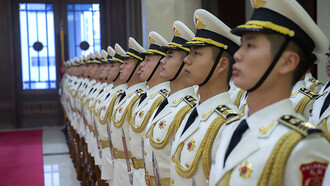Authorities of North Korea (officially the Democratic People’s Republic of Korea, DPRK) have long denied the presence of dehumanizing labour, internment, and concentration camps in their small nation, despite overwhelming evidence for their existence. One such piece of evidence is a report published in 2014 by the United Nation’s Human Rights Council, which not only recognized the presence of these camps, but acknowledged the brutality occurring within. Perhaps unsurprisingly, there was a brief wave of international shock and condemnation, which soon petered out, distracted by the next humanitarian disaster.
The Report of the commission of inquiry on human rights in the Democratic People’s Republic of Korea was published almost exactly a decade ago, on February 7th, 2014. The report contains the detailed findings of the UN commission, presented in the Human Rights Council’s twenty-fifth session as agenda item 4: “Human rights situations that require the Council’s attention.”
The report, although administrative and objective, is written passionately and provides a strong case against the North Korean government and its abhorrent history of human rights violations. Select excerpts from the report include: “There is an almost complete denial of the right to freedom of thought, conscience, and religion, as well as of the rights to freedom of opinion, expression, information, and association” (III. A. 26.) and “the State operates an all-encompassing indoctrination machine that takes root from childhood to propagate an official personality cult and to manufacture absolute obedience to the Supreme Leader” (III. A. 27.).
Part C of section III. Principal Findings of the Commission outlines Violations of the freedom of movement and residence, where the authors (Michael Donald Kirby of Australia, Sonja Biserko of Serbia, and Marzuki Darusman, the Special Rapporteur on the situation of human rights in the DPRK) write:
[North Korean] nationals still take the risk of fleeing, mainly to China. When they are apprehended or forcibly repatriated, officials from the DPRK systematically subject them to persecution, torture, prolonged arbitrary detention, and, in some cases, sexual violence, including during invasive body searches. Repatriated women who are pregnant are regularly subjected to forced abortions, and babies born to repatriated women are often killed. (III. C. 42.)
Among the violations investigated by the commission were those pertaining to the right to food, freedom of expression, torture and inhumane treatment, arbitrary detention, those associated with prison camps, the right to life, and freedom of movement.
Sadly, the horrific conditions in North Korea are already relatively well-known internationally. Memes abound, including one image of a Korean man mowing a grassy field and collecting the clippings, sarcastically captioned “grocery shopping in North Korea.” The leader of the DPRK, Kim Jong Un, frequently threatens the west with nuclear war, claiming to possess warheads and ballistic missiles capable of reaching the United States. Despite this, little attention is focused on intervening. This contrasts with the case of 2003 Iraq, for instance, which also saw dire humanitarian conditions and political oppression, but which was eagerly occupied by an international military coalition which, unable to discover any weapons of mass destruction, nevertheless occupied the country with the noble aim of liberating the nation’s oil – I mean, people.
It boggles the mind to think of what the difference could be in these two cases.
As in the case of Iraq under Saddam Hussein, a “climate of fear” has been established in North Korea through the imposition of panoptic government surveillance:
The police and security forces of the Democratic People’s Republic of Korea systematically employ violence and punishments that amount to gross human rights violations in order to create a climate of fear that pre-empts any challenge to the current system of government and to the ideology underpinning it. The institutions and officials involved are not held accountable. Impunity reigns. (III. E. 56.)
The Human Rights Council’s Resolution A/HRC/RES/22/13 instructed the body to investigate the systematic, widespread, and grave violations of human rights in the DPRK with the goal of ultimately ensuring full accountability for violations which may amount to crimes against humanity. Although the North Korean government continued to deny the existence of its concentration camps, the global community (including South Korea and the United States) estimated “between 80,000 and 120,000 political prisoners” being detained in “four large political prison camps” (III. E. 61.). In this and many other stark ways, the actions of the North Korean government “resemble the horrors of camps that totalitarian States established during the twentieth century” (III.E. 60.). One difference, however, is that the North Korean camps have existed for twice as long as did the Soviet gulags under Joseph Stalin, and a whopping twelve times as long as Nazi concentration camps.
The report finally accused the DPRK government of crimes against humanity, supported through documented victims’ testimonies, interviews with defectors, and the accounts of survivors, witnesses, and perpetrators. An overwhelming amount of evidence was stacked behind these accusations, many of which suggested a lack of humanity in the state and the inability (or disinclination) on the part of Kim Jong Un and his government to correct decades of violence and corruption:
These are not mere excesses of the State; they are essential components of a political system that has moved far from the ideals on which it claims to be founded. The gravity, scale and nature of these violations reveal a State that does not have any parallel in the contemporary world. Political scientists of the twentieth century characterized this type of political organization as a totalitarian State: a State that does not content itself with ensuring the authoritarian rule of a small group of people, but seeks to dominate every aspect of its citizens’ lives and terrorizes them from within. (V. 80.)
In an effort to raise attention to the disastrous conditions in North Korea, two former prisoners, Kim Kwang-Il and Shin In Geun, prepared a small collection of graphic drawings depicting the conditions of the labour camps. The drawings have been published online for some time, originally commissioned for Kim Kwang-Il’s contributions to the book Evidence Jeongeori Prison and Shin In Geun’s biography Escape from Camp 14. The drawings, alongside the landmark UN report, constitute a portfolio of compelling evidence that demands accountability for the North Korean state, the introduction of humanitarian assistance and labour laws, and the immediate closure of the camps.
Defector Kim Kwang-Il escaped North Korea in 2012 after spending nearly three years in an internment camp for the crime of smuggling pine nuts across the border. After escaping to South Korea, Kim prepared a series of drawings of his experiences in the North Korean gulag. The drawings are very simple, executed with only enough detail to relay the horrors of the camp. They are not for the faint of heart, however, so I have not included them in this article, but you can view them at Amnesty International.
One drawing shows two prisoners chained to a wall in the “pigeon pose,” a stress position that prisoners must hold until they vomit blood. Another shows three stress positions called “crane,” “airplane,” and “motorcycle,” where prisoners must stand for days until they can fill a glass with their sweat. Prisoners are seen eating rats and snakes out of starvation, and inmates are forced to carry the dead up hills to a crematorium where they’re discarded. These drawings were included in Evidence Jeongeori Prison, which was published by the UN Human Rights Council in tandem with its report on the DPRK.
The other former prisoner, Shin Dong-hyuk (born Shin In Geun), is believed to be the only successful escapee of a “total-control zone” internment camp in North Korea. His story has been published as Escape from Camp 14: One Man’s Remarkable Odyssey from North Korea to Freedom in the West by journalist Blaine Harden. The authors of the UN commission of inquiry of North Korea described Shin as the world’s “single strongest voice” on the horrors of DPRK concentration camps, and he now works as an advocate for human rights. Like Kwang, Shin commissioned a series of drawings for his book. The style of these drawings is more detailed, but the details are used as much to create a sense of space as for aesthetic aims. In one drawing, a pregnant woman is forced to mimic the positions of a clock’s hands for hours until dehydrated, while an audience of pale, gaunt, spiritless prisoners look on. Shin’s drawings also show forced abortions, prisoners being beaten as stress relief for guards, and the consumption of rats and snakes in the search for a small amount of protein and sustenance.
In closing, I offer the conclusion of the UN report:
The fact that the Democratic People’s Republic of Korea, as a State Member of the United Nations, has for decades pursued policies involving crimes that shock the conscience of humanity raises questions about the inadequacy of the response of the international community. The international community must accept its responsibility to protect the people of the Democratic People’s Republic of Korea from crimes against humanity, because the Government of the Democratic People’s Republic of Korea has manifestly failed to do so. (V. 86.)
References
1 Harden, Blaine. Escape from Camp 14: One Man’s Remarkable Odyssey from North Korea to Freedom in the West. London: Penguin Books, 2013.
2 Report of the commission of inquiry on human rights in the Democratic People’s Republic of Korea, Human Rights Council in its 25th Sess., Agenda item 4, U.N. Doc. A/HRC/25/63 (Feb 7, 2014).















